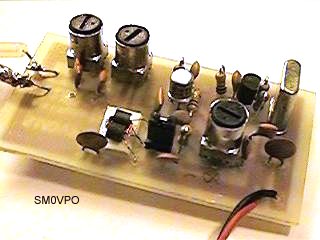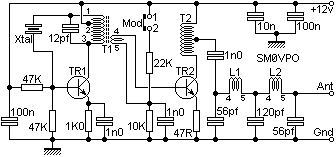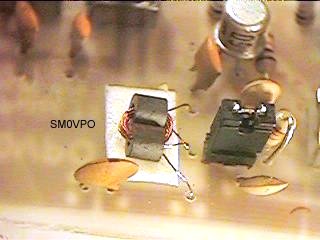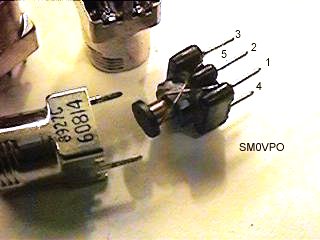

The 27MHz radio control receiver project and the proportional R/C encoder/decoder project were created many years ago. The transmitter portion has never been published. In fact I never even used a PCB for the TX board since it was developed using "rats-nest" (Ugly-bug) design. I was more interested in getting the model into the air quickly. There have been a few different transmitter versions, but I have now remade the first one, and made a PCB for it. It did include a few surprises for me, so let me share them with you, too.

One thing I tend to do is to make a project do double-duty, after all, you can drink Coca Cola, or you can use it to clean coins or etch PCBs. The original TX was designed to be only PULSE Modulated for a proportional R/C system, but I later used the same circuit to make an HF bands Amplitude Modulation (AM) transmitter using PA-Base Modulation. It eliminated the need for a modulation transformer; it can be driven with a simple Op-Amp amplifier. Frequency range of the original prototypes were as low as 1MHz and the top frequency was 40MHz. The circuit is the same, just the crystal and coils are changed. The CW output power is about 200mW at 29MHz. It is only 70mW Amplitude modulated, but modulation peaks can rise to 200mW with 80% modulation.
The transmitter is quite small, only about 60mm. x 35mm. so it easily forms a single transmitter module inside the case of any other peice of equipment, such as an R/C transmitter or a Hamradio portable rig. This is the PCB version. The final PCB has had a couple of changes around the oscillator stage.


The circuit is almost ridiculously simple, and construction is even simpler. It is basically a single transistor oscillator with a very low output impedance, suitable for driving the base of another transitor amplifier stage.

The oscillator uses a single coil and crystal. The coil is tuned to the output frequency, which may correspond to the crystal frequency, or a harmonic, for example you my like to use:
| Crystal Oscillation Mode | Min Freq | Max Freq |
|---|---|---|
| Fundamental frequency | 1MHz | 25MHz |
| 2nd Harmonic frequency | 10MHz | 35MHz |
| 3rd Harmonic frequency | 20MHz | 40MHz+ |
The above table does NOT contain rules. You may have a 3.5MHz CW crystal, but there is no reason why you cannot tune the oscillator to 7MHz. It will work with the fundamental, 2nd harmonic, 3rd and 5th. The output power will reduce at higher harmonics and frequencies are chosen.
The power amplifier is quite straight-forward. The amplifier is biased as a linear amplifier with the collector load matching the 200 Ohms collector impedance to 50 Ohms with T2. L1 and L2 plus the three capacitors for an output low-pass filter.
Modulation is applied to the base of TR2. The MOD link is removed and pin 2 is varied from 0vDC to 12vDC to vary the TX output power from zero to full power. Pins 1 and 2 may therefore be coupled directly to a morse key and you have an HF bands QRP CW transmitter. The capacitor across the 10K resistor will also adjust the keying envelope. Leave it at 1n0 for radio control use, but increase it to 100nF for good morse. On the band this transmitter sounds surprisingly clean and well formed. Since the oscillator is continuously running, there is absolutely no chirp. Adjusting the tuning of T1 will adjust the frequency by a couple of KHz.

Yes, it uses coils, four of them! I will leave it up to you to find out how many turns to use on a windy day, or in fine weather. I will just give you a guide:
| T1 | PRIMARY = 80% with tap at 10%. SECONDARY = 10% |
| T2 | 15+15 turns biflar. The two windings series connected to form a centre-tapped coil of 30-turns. |
| L1 | 40% |
| L2 | 40% |
The percentages are wavelength in Metres expressed in turns. For example, for 27MHz - 30MHz range, the wavelength is 10 Metres. 10% is therefore 1 turn. 80% is 8 turns. This all assumes you use re-wound formers, as I used. If you use a different former then you are on your own! T2 worked for me from 3.5MHz to 35MHz. You may need a few more turns if you intend to go lower in frequency. The coil is wound on two ferrite beads placed side-by-side as a pair of, er! "cockroach binoculars". Look, this picture shows you what I mean.

Notice that the MOD link is also shown. I have just stuffed a computer board link on two posts for testing. A 2-pin plug can then be substituted for connection to another board or morse key. The coils T1, L1 and L2 are wound on re-used IF cans, as found/stolen from transistor radio sets. They are all very similar in incuctance/turn and the number of turns is quite a crude figure. It should work for most of these coils. Just take them apart gently and remove the existing coils. These are best clipped/unwound instead of mashed/dragged off; screaming and kicking.

New turns are then added. I suggest you tin one end of wire (robbed from old relays or transformers - wire gauge = very "thin-ish"). Wind the coil then tin the wire before wrapping 2 turns around a leg and soldering. The wire is best stripped/tinned with an iron of 350 degrees C, but solder coil legs with a much cooler iron, ca: 250 C or you may melt the plastic body of the coil.
You should also scale the 12pf, 56pf and 120pf capacitors in direct proportion to the transmitter output WAVELENGTH.

Position the components on the board and solder them. I don't think I can add more to that, except to say that you should follow the PCB board component layout I have given. Vertically mounted resistors have a long wire and a short wire. The long one should not have any RF on it. The circuit is quite forgiving in that it can be built birds-nest/ugly-bug style and still have a clean output. Mine had all unwanted harmonics better than -45dBc.
The transistors can be 2N2222 or BC547 up to about 20MHz. After that the power starts to fall. Changing TR2 to BC108 is great to about 35MHz. Above 35MHz then BSX19 or BSX20 (a good RF transistor) should be used as the PA stage.

This little transmitter is a good stable QRP transmitter that has loads of uses, from HF bands AM broadcast transmitter, radio control of models or an AM / CW ham-bands transmitter. I hope that you have fun with it. The PCB will soon be available from my downloadpage.
Very best regards from Harry Lythall
